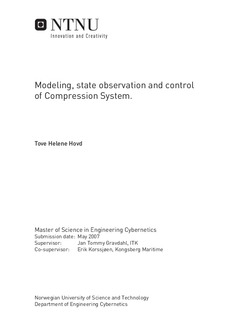| dc.contributor.advisor | Gravdahl, Jan Tommy | nb_NO |
| dc.contributor.advisor | Korssjøen, Erik | nb_NO |
| dc.contributor.author | Hovd, Tove Helene | nb_NO |
| dc.date.accessioned | 2014-12-19T14:01:28Z | |
| dc.date.available | 2014-12-19T14:01:28Z | |
| dc.date.created | 2010-09-03 | nb_NO |
| dc.date.issued | 2007 | nb_NO |
| dc.identifier | 347453 | nb_NO |
| dc.identifier | ntnudaim:3336 | nb_NO |
| dc.identifier.uri | http://hdl.handle.net/11250/259600 | |
| dc.description.abstract | The need of simulation models for physical systems is essential in all phases of its lifetime. During construction better decisions can be made and difficulties discovered. When running observers one can use the model to estimate states. Knowledge of the system is also needed to develop good control strategies. A compression system without surge avoidance recycling exists, and its mathematical development and simulation model was studied and simulated. Kalman filters were developed in theory, four filters were designed and lastly implemented. A study of industrial solutions for surge avoidance was performed, with attention to practical building, measurements, mathematical modeling and control. The study resulted in three simulation models for recycling that were fitted to the compressor at hand. Lastly a surge avoidance system was implemented on the model most likely to be built. A good simulation model of the existing compressor is available, and using this three well working Kalman filters were implemented. A fourth filter yielded non-unique and sometimes unstable estimates, and emphasized the importance of retrieving enough information from the measurements to estimate the correct state. All recycle system models used the characteristics of the existing compressor. The solution most likely to be implemented and form basis for a simulation model recycled gas directly downstream of the compressor. The other two models retrieved the recycled gas from the plenum, however this will change the dynamics of the system. These were not considered practical solutions for the specific system. The surge avoidance scheme worked well for production close to the surge line and small set-point changes. It also worked well for large changes in speed, but will surge if the speed becomes too low. The controller scheme did not work well when a large change in plenum throttle occurred, the recycle valve was then too slow. Future work consists of building a recycle loop, develop simulation model and implement surge avoidance scheme for academic purposes. | nb_NO |
| dc.language | eng | nb_NO |
| dc.publisher | Institutt for teknisk kybernetikk | nb_NO |
| dc.subject | ntnudaim | no_NO |
| dc.subject | SIE3 teknisk kybernetikk | no_NO |
| dc.subject | Reguleringsteknikk | no_NO |
| dc.title | Modeling, state observation and control of Compression System. | nb_NO |
| dc.type | Master thesis | nb_NO |
| dc.source.pagenumber | 126 | nb_NO |
| dc.contributor.department | Norges teknisk-naturvitenskapelige universitet, Fakultet for informasjonsteknologi, matematikk og elektroteknikk, Institutt for teknisk kybernetikk | nb_NO |

